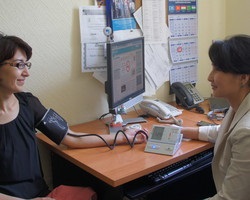A new systematic review highlights a surprising yet significant factor in patient care: physician posture. According to recent research conducted by the University of Michigan and VA Ann Arbor Healthcare System, sitting or crouching at a hospitalized patient’s bedside can lead to improved trust, satisfaction, and even better clinical outcomes compared to standing.
Published in the Journal of General Internal Medicine, the study examines the effects of clinician posture on patient experiences and health outcomes. The researchers identified a gap in consistent evidence regarding this aspect of patient care. The review included 14 studies, though only two were rigorous experiments. Despite the variability and high risk of bias in the studies, a pattern emerged: patients generally respond more positively when clinicians are at eye level.
Nathan Houchens, M.D., a faculty member at the U-M Medical School and a hospitalist at the VA Ann Arbor, notes the significance of this non-verbal factor in the hierarchical dynamics of hospital care. By physically lowering themselves to the patient’s eye level, physicians can potentially alter the power dynamics and foster a stronger, more empathetic connection.
“The data suggests that patients prefer when clinicians sit or kneel rather than stand over them,” Houchens explains. “This simple adjustment can make a substantial difference in patient perceptions of empathy and overall satisfaction.”
To facilitate this change, Houchens and his team suggest practical measures such as providing folding chairs and stools in patient rooms. The VA Ann Arbor has already implemented this approach, equipping many rooms with such seating to encourage bedside sitting.
Despite the benefits, Houchens acknowledges challenges, including concerns about the time required for sitting versus standing and potential issues with infection control. However, the evidence reviewed suggests that sitting does not necessarily prolong interactions or compromise patient care efficiency.
This new research also aligns with broader efforts to improve hospital environments. The recently launched M-Wellness Laboratory study, funded by the Agency for Healthcare Research and Quality, incorporates physician posture as part of a comprehensive bundle of interventions designed to enhance patient-provider interactions. Alongside encouraging warm greetings and personal engagement, the study will assess the impact of these measures on patient outcomes, including hospital length of stay and readmissions.
The findings underscore the importance of simple, yet impactful changes in clinical practice. Encouraging physicians to adopt a more seated posture and senior staff to model this behavior could foster a more supportive and effective healthcare environment.
For more information on this study, refer to: Houchens, N., et al. (2024). Effect of Clinician Posture on Patient Perceptions of Communication in the Inpatient Setting: A Systematic Review. Journal of General Internal Medicine. doi.org/10.1007/s11606-024-08906-4.












